As the eСommerce market keeps expanding, business owners invest in innovations to match this growth. New features pop up, and existing platforms are adjusted to match the rising scale of operations. Headless ecommerce stands out among these transformative changes, with Adobe spearheading the shift.
Any business focused on online sales has at least heard of the headless Magento approach of splitting front-end and back-end to make both more flexible. Some even know that it results in more optimized and scalable storefronts, bringing eCommerce up to modern standards.
But only those who have tried headless Magento can see that uncoupling the site’s visuals from its back-end gives businesses a chance to customize every single detail, which puts an accent on brand identity and uniqueness.
In this guide to headless Magento for business, Atwix will explain what this technology entails and how it can be used to boost your store. Through practical use cases from our experience with Magento and beginner tips, you will see the full potential of this Adobe-powered technology.
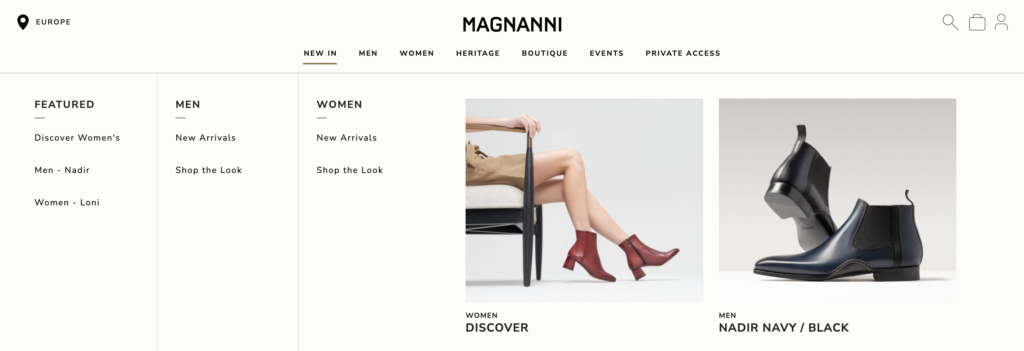
Getting a Closer Look at Headless Magento
Regular Magento structure, usually called “monolithic”, has all parts of a web store connected and interdependent. This has been the default for years, and it worked well in the past.
However, as mobile eCommerce takes over, there is a stronger accent on speedier, flexible websites. This leads to headless, which splits the platform into three distinct components:
- Front-end
- Back-end
- Connecting API
While frontend and backend functionalities are separated from one another, they communicate via an API. One doesn’t need to change when the other does. This effectively means that each can be optimized and prioritized in their own way, while your store will keep operating as if nothing happens.
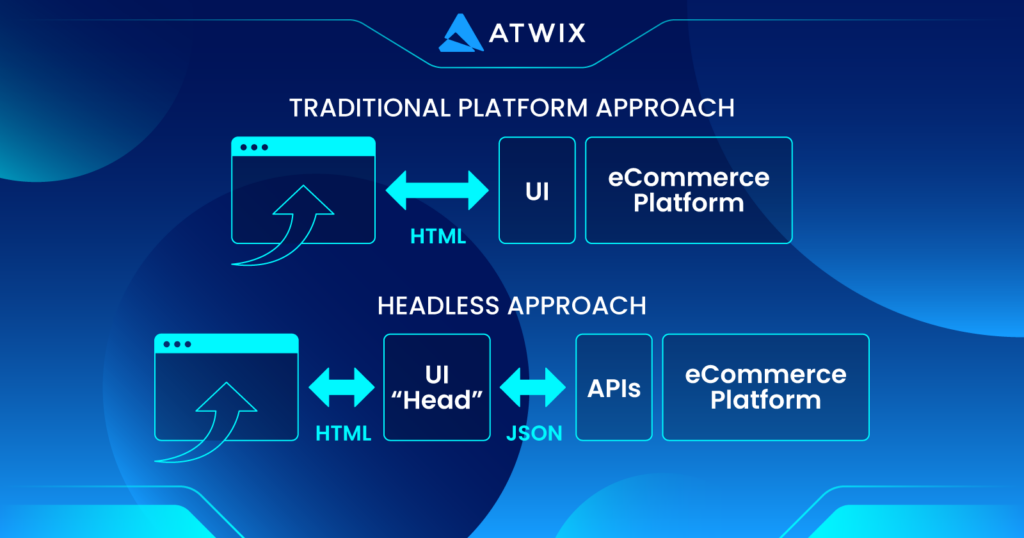
The image above illustrates the split, with the UI being connected via JSON files, instead of a direct link to the backend database. That way, frontend data isn’t being generated on the backend of the platform, which changes the website processes in full.
As a result, Magento 2 headless completely reimagines its past obsolete approach and opens new horizons for retailers ready to innovate.
Transformational Benefits of Headless Magento
Any tool works best when it’s used for its intended purpose. Headless Magento is designed to be flexible and scalable, with a focus on customization that beats out the competition. By choosing to go headless, you can achieve the following:
- Greater flexibility
- Faster development
- Improved performance
- Better scalability
- Enhanced customer experience
- Omnichannel commerce
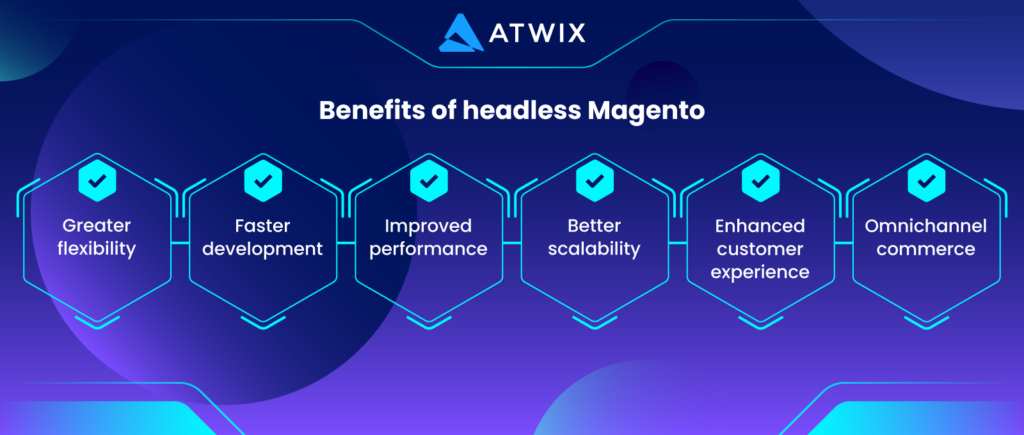
Greater Flexibility
One of the chief headless Magento benefits is the freedom to customize your backend and frontend independently. You don’t have to worry about backend loading when adding new features on the frontend and vice versa. This opens up room for experimentation and makes development easier for your team.
Faster Development
With no need to coordinate changes between the frontend and the backend, your team can split resources equally and work faster on testing and pushing any additions. This speeds up the delivery of the store as well as its further maintenance.
Improved Performance
As the platform components are independent, the number of resource-heavy processes is much lower with headless. This means faster loading times, which is crucial for keeping clients satisfied. Moreover, since the store will load quickly, you can play around with extra widgets and visual elements to make your website more interactive.
On the architecture side, your frontend processes will be essentially using a different resource pool than the backend. So if the backend is under heavy load, the frontend processes will still have something to work with. Headless Magento opens the door for a more impressive UI without sacrificing speed.
Better Scalability
Magento is traditionally seen as a monolithic platform. But because it’s open-source and developers can twist and turn the code in all ways imaginable, we can make it headless and connect any other third-party system or interface. This is a huge change from monoliths, where any new functionality or change will affect the whole system and might potentially produce a ripple effect. This, in return, could lead to performance issues as the store gets more complex and uses more resources with things entangled.
On the other hand, headless architecture can scale with extra resources. With backend and frontend not joined together, your team will be able to change things independently. That way, some parts of the system can be fine-tuned and scaled, while leaving the others stable. It’s not the easiest process, of course, but with a skilled team of developers, headless truly shines.
Enhanced Customer Experience
The improvement in user experience is the cumulative result of faster loading, the ability to introduce extra functions, and more flexible integrations with third-party systems. After all, any customer would prefer a more efficient and unique site. And with the ability to add more resource-intensive and modern features, such as AI-powered recommendations and AR visualizers, you can improve the customer journey through your store and make it more intuitive.
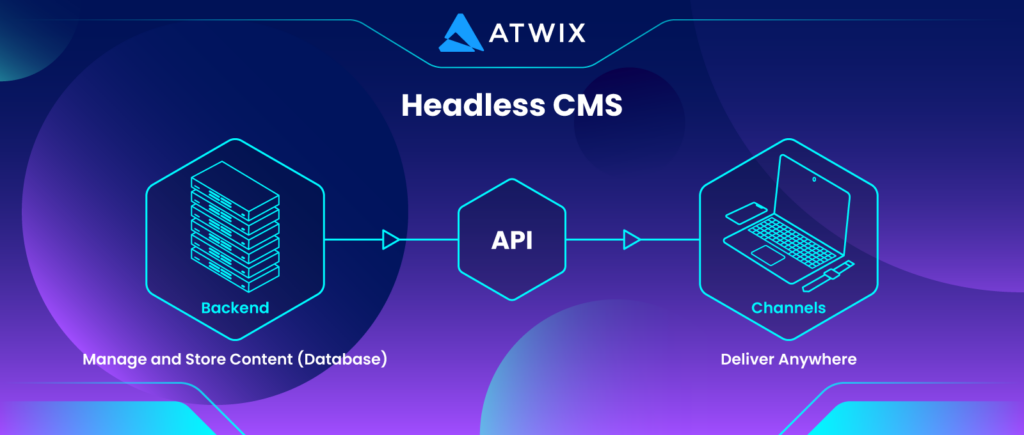
Omnichannel Commerce
Adapting to your customers’ needs or, more precisely, their devices is a major advantage. If you choose to go headless, you’ll be able to connect multiple frontends or “heads” to your back-office system. These can be modified to fit mobile, desktop, or even less-common devices like smart watches. With several different content management systems, you can tailor the experience to different target audiences entirely.
Moreover, modern customers tend to hold off on purchases, typically interacting with the site through multiple devices. Omnichannel helps the seller keep up with such rising expectations and meet the buyer where they are.
Implementing omnichannel B2B strategies enhances customer engagement across all platforms, fostering loyalty and increasing sales.
Going omnichannel also means you can take down one of the “heads” for maintenance while keeping others active. Achieving improvements without downtime is an essential benefit in a highly competitive industry.
Use Cases for Headless Magento
While Magento benefits may sound exciting, it’s not always easy to apply them. If you face some challenges here, you can rely on our experience with the platform and check out our full list of Magento development case studies for more inspiration.
Find the list of the most popular use cases that take full advantage of the headless approach.
Custom Shopping Apps
If you have an idea for an app that isn’t supported by any existing ecommerce platform, headless may be the way to go. The enhanced flexibility of this Magento format will allow you to implement a whole new functionality. While other platforms like Shopify support custom apps, they don’t focus on providing extra resources or easy ways to link various systems.
For a real-world example, Atwix has used Magento’s flexibility to create an infinite scroll for Interior Define’s web store. This allowed the brand to show off their products easier while customers could access more choices without having to navigate the site at all.
The unique aspect to headless is its ability to combine different technologies without inseparably linking them. Regular Magento wouldn’t be able to grant this freedom and, thus, any innovators in the field would be better served by choosing Magento headless commerce.
B2B Service Portals
The main reason headless works well for a B2B environment is the scaling. Companies can hop onto your portal and grow without any concerns about performance stability. This allows the platform to thrive and expand the pool of both vendors and customers. Plus, using RESTful or GraphQL API, businesses can manage and modify their content.
Similarly, the omnichannel nature of headless lets businesses try out multiple approaches to customers. In contrast to traditional systems that somewhat restrict the types of businesses you can work with, headless also makes your portal more attractive. Atwix tested this by helping Coastal Business Supplies add B2B eCommerce to their website.
Product Configurators
Modern stores tend to focus on a customizable experience, letting clients change products how they see fit. This facilitates lending sales but requires flexibility and a product configurator. Headless is a preferred choice in this regard, providing basic customization and advanced visualization abilities that usually require extra resources.
Ideally, you want to let the customer configure almost everything about the product. Thus, the tool should account for every step of manufacturing without taking too long to visualize the changes. This is easier to do with headless, which minimizes the resource load while still letting the configurator work seamlessly.
Atwix helped out Byrne with this exact goal, completely retooling their old site. With ERP integration and full product customization, the business reinvented itself and focused on their customers’ satisfaction.
Read also: The popular ERPs to Integrate with Magento.
Digital Marketplaces
Using the omnichannel options of headless is a great way to make your marketplace more welcoming to different audiences. By adapting your storefront to a variety of devices and visual preferences, you can outpace the competition just by offering more flexibility to customers. Plus, with headless, these visual adaptations will not slow down the site, making UX better.
For example, Cabinets, a sprawling marketplace, was struggling with a somewhat outdated Magento store. Atwix upgraded the inner workings of the site to make navigation simpler and purchasing more streamlined. This helped make Cabinets a more UX-oriented marketplace.
Content-Driven Commerce
The booming trend of relying on content for higher conversions and brand appeal can be reinforced through Magento flexible customization. With headless removing the limits on how much you can change about your website, it gets easier to create unique content that sets you apart. One of our favorite examples is HYPERVSN, a futuristic company that has a site to match, courtesy of Atwix.
It would be wise for businesses that want to emphasize visuals to break out of the restraints set by traditional platforms. By relying on the headless approach instead, you can use omnichannel and highly customized store themes to make your content pop, all in the name of savvy, modern marketing.
Where to Start with Headless Magento
Having heard all the benefits of headless and its possible applications, you only need to set the roadmap. While it’s possible to approach this in a variety of ways, here is what Atwix recommends based on our own experience.
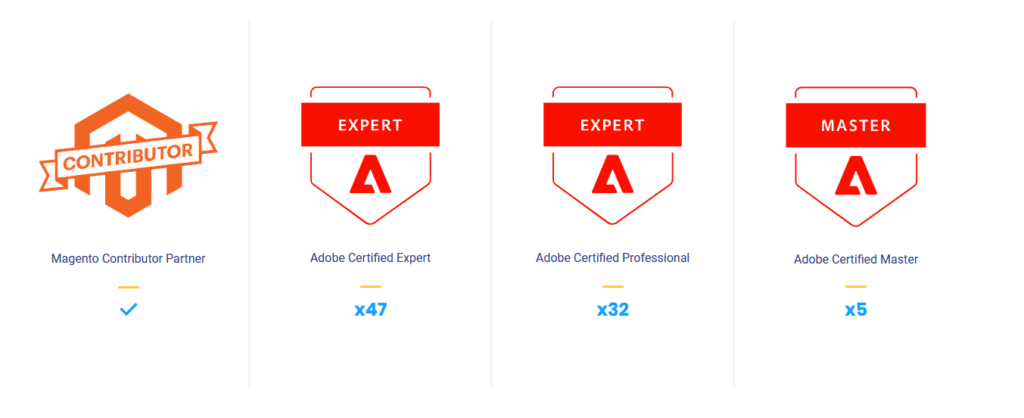
Choose a Reliable Headless Magento Development Partner
The deep customization and flexibility that headless opens up have a dark side, which is the need for a team of experts to do the development. While expertise is always good, Magento is a sprawling platform, and, more than any other, headless will test any developer’s skills.
For example, as a Magento development agency, Atwix has been in business since 2006, providing its headless Magento development services for more than a decade. A handful of Magento certifications and credentials will also reassure you you’re in the hands of pros. It’s important to evaluate your partner based on their reputation and choose the best.
Choose a Technology Stack
Your development partner will come in handy right away as they can give tips on everything based on the type and scope of the project you’re using headless for. Having someone to consult and help you make difficult choices, such as picking between Angular, React, and Vue.js for your frontend, will make things easier.
Develop a Strategy
Headless is a major shift from traditional development and usually has a longer time-to-market. That means your regular methodology may not work too well, requiring you to shake up your workflow. Our advice is to concentrate two separate teams on the frontend and backend, so they can implement functionality for both simultaneously.
Implement Your Headless Magento Solution
This is when the actual development process happens. You can still adjust certain directions and plans on the go, but it’s best to keep that to a minimum. What matters most is extensive testing to make sure your customers will get a polished and perfected product.
Head Into the Future of Commerce
Partner with a market leader like Atwix, a certified Magento agency, and start innovating your customer experience.

Let’s Start Your Magento Journey
Reinventing your store can be a major change. But with a skilled team handling development, headless will really boost your business.
Any company looking to make their store more unique, implement innovative features, or just optimize their customers’ experience should consider headless ecommerce. As a business owner, you always should look for ways to take your company to the next level 0 and that’s what headless Magento is for e-commerce.
To get started with your transformation to Magento’s headless structure, reach out to Atwix for a consultation and other services like Magento maintenance services.
Frequently Asked Questions
Got some questions? We’re here to answer. If you don’t see your question here, drop us a line with out Contact form.
What is headless Magento?
In short, it’s a modification to the open-source Magento platform. Headless simply means that the front-end (the head) and the back-end of the site will not depend on each other. That results in a site that’s well-optimized, can be configured without going down for maintenance, and supports omnichannel commerce.
Why should I use headless Magento?
If you want your store to attract customers, it needs to stand out. Going headless gives much more freedom to customize your website’s look and features. Magento AI integration can further enhance a headless setup by delivering personalized experiences and smarter product recommendations. There is no better way to distinguish yourself from the competition than by making sure your store is unlike any other.
Do I need to hire a headless Magento development partner?
That depends on what kind of professionals you have on your own team. Magento is a sprawling platform with a lot of moving parts. If nobody in your company specializes in Magento development, it’s best to get the help of an experienced agency.
What are the potential challenges of implementing a headless Magento architecture?
Implementing headless Magento can require a higher initial investment and more advanced technical expertise compared to traditional setups. Businesses may also face challenges in integrating the front-end with the back-end, managing multiple tools, and ensuring proper API functionality. Partnering with an experienced development team can mitigate these risks.
How does headless Magento improve omnichannel customer experiences?
Headless Magento enables businesses to deliver consistent and seamless customer experiences across multiple channels, such as web, mobile apps, kiosks, and IoT devices. By leveraging APIs, businesses can provide tailored content and functionality to each channel, ensuring an optimized shopping experience for customers.
